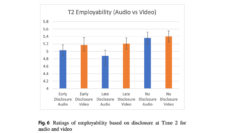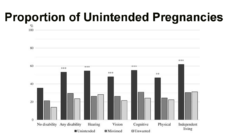One in five women experience sexual assault or rape during their lifetime in the United States. Rates are even higher for women living with disabilities. The CDC estimates that 39% of female victims of rape have a disability when a sexual assault occurs. Yet with more studies and reports coming out in recent years highlighting the risk of sexual violence against women with disabilities, this epidemic is still understudied in sexual violence research.
Emily Ledingham and team compared reports of sexual violence experienced by women with disabilities to the reports from women without disabilities. The team looked at responses from 14,276 women between the ages of 18-44 who participated in the National Survey of Family Growth between 2011-2017.
Seventeen percent of female survey respondents without disabilities reported being forced into vaginal intercourse by a male at least once in their life, compared to 32% of women with any disability. Force was defined by either physical or non-physical force—such as being given alcohol or drugs, verbally pressured, physically threatened, and/or emotionally manipulated—again higher among women with disabilities.
The information provided by participants with disabilities was broken down by disability type: sensory, cognitive, physical, and multiple disabilities. Compared to women without disabilities, respondents with each disability classification were roughly twice as likely to report ever experiencing sexual violence. However, 42% of respondents with two or more disabilities were the most likely to report ever experiencing sexual force.
A woman with disabilities was also twice as likely to be 12 or younger the first time she experienced sexual intercourse than a woman without a disability.
A woman with disabilities was also twice as likely to be 12 or younger the first time she experienced sexual intercourse than a woman without a disability.
The authors discuss why women with disabilities have a heightened risk of experiencing sexual violence: the increased reliance on caregivers, communication barriers, being perceived as less credible victims, but most notably, the pervasive societal stigma against people with disabilities.
Schools often exclude disabled students from general sex ed courses because an ableist society has often illustrated people with disabilities as asexual, undesirable, or forever children.
Only three states require inclusion of students with disabilities in sex education and 36 states do not incorporate students with disabilities into their sex education requirements at all. Sex education is a primary preventive measure against sexual violence. Education on sexual assault, sexual rights, and consent provides tools to help recognize potential sexually violent situations and could help reduce incidents of sexual violence. Early education about sexual assault support resources is also imperative.
Ledingham’s study provides supporting evidence for a fairly new area of research that the disabled community has dealt with silently for years.
Photo via Getty Images














